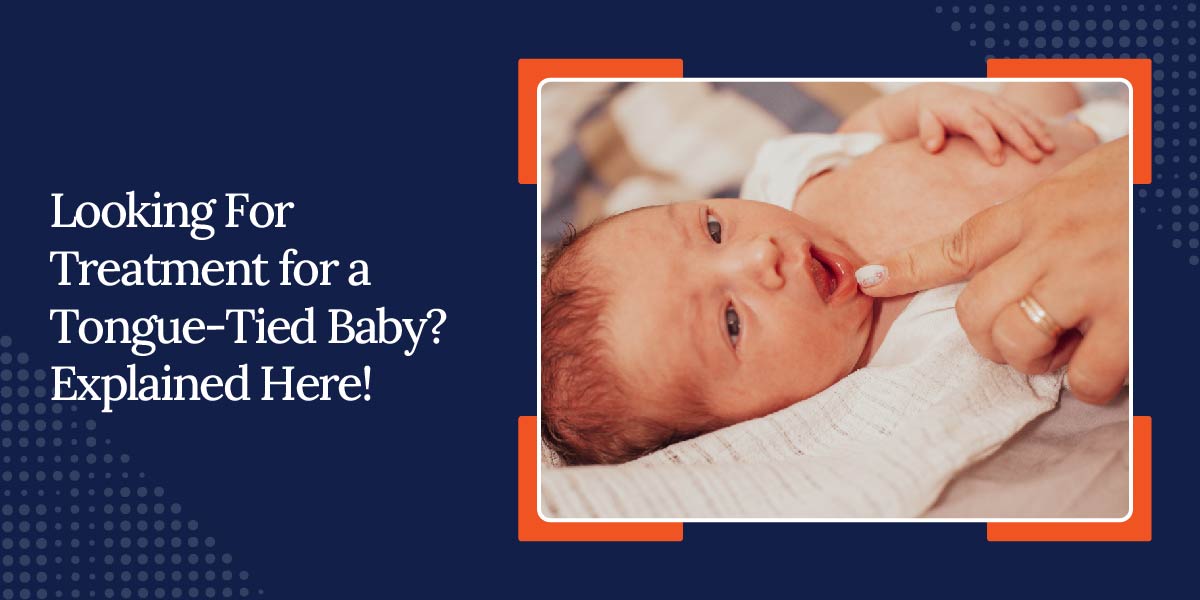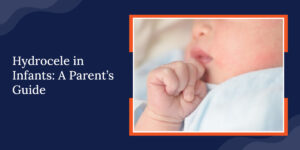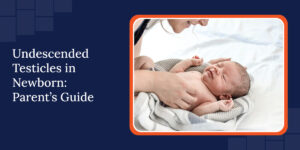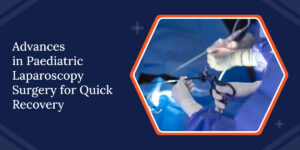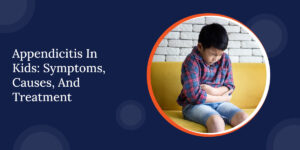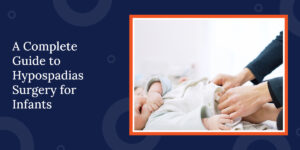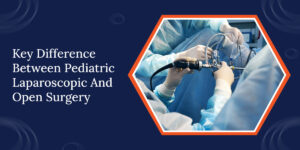Have you noticed your newborn baby struggling while feeding, and are you wondering why breastfeeding feels like an uphill battle? Many parents face this heart-wrenching scenario without realising their baby might have a condition known as tongue-tie or ankyloglossia. It is a common yet often unrecognised condition that occurs when a short, tighter band of tissue called the lingual frenulum restricts the tongue movement, causing severe difficulties while feeding the child and potentially affecting overall development.
Understanding treatment for a tongue-tied baby is crucial for every parent for the optimal health and well-being of their child. In this guide, we will cover how to identify, diagnose, and treat this condition for effective treatment.
A] What Exactly is Tongue-Tie (Ankyloglossia)?
Tongue-tie, also called ankyloglossia, is a congenital condition where the lingual frenulum (the thin strip of tissue connecting the tongue to the mouth’s floor) is so unusually short, thick, or tight that it restricts the tongue’s movement, which is required during feeding, swallowing, and later, speech development.
This condition is usually genetic, though the exact developmental mechanisms remain under scientific investigation. Studies say that tongue-tie symptoms in babies manifest differently depending on the severity and location of the restriction.
Types of Tongue-Tie:
- Anterior Tongue-Tie: It is visible on the tongue tip and easy to identify.
- Posterior Tongue-Tie: This is located deeper, occurs in the back part of the tongue, and is more difficult to detect.
Book a Consultation for Tongue-Tie Treatment Today!
B] How to Identify Tongue-Tie: Signs and Symptoms in Babies and Mothers
Could your baby’s feeding difficulties be signs of tongue-tie? Recognising tongue-tie symptoms in babies early can help prevent months of frustration and even potential health issues.
Symptoms to look for:
- Continuing difficulty latching during breastfeeding
- Gum cracking during feeding
- Much cracking of the seal during nursing
- Poor weight gain even after frequent attempts to feed the child
- The inability to extend the tongue beyond the lower gum line
- Heart-shaped or notched tongue tip when crying
Maternal symptoms often include:
- Intense nipple pain and trauma can be experienced
- Recurring blocked ducts or mastitis
- Feeling that the baby is not extracting the milk effectively
Identifying the symptoms as early as possible is key, as the sooner parents understand what it is and why it happens, the faster appropriate treatment of a tongue-tied baby can begin to prevent any other long-term complications.
C] Diagnosing Tongue-Tie: What to Expect
Several healthcare professionals are available to diagnose this disease, such as a paediatrician, lactation consultant, ENT specialist (otolaryngologist), pediatric dentists, and oral surgeons who have experience in assessing infants. The diagnostic procedures usually comprise the following steps:
This diagnosis usually follows the following process:
- Physical Examination: Doctors assess the length of the frenulum, its thickness, and the area of its attachment while monitoring the motion and the functioning of the tongue.
- Functional Assessment: The movement of the tongue during feeding, swallowing and crying can indicate vital diagnostics.
- Standardised Assessment Tools: Many practitioners use standardised assessment tools such as the Hazelbaker Assessment Tool for Lingual Frenulum Function (HATLFF) to ensure accurate diagnosis and plan the treatment.
D] Treatment Options for Tongue-Tied Baby
The treatment options depend on the severity, symptoms, and effects of tongue-tie on overall health in infants. Below are a few available non-surgical and surgical options:
Non-Surgical Approaches (Conservative Management)
- Lactation Consulting and Feeding Support: Experienced lactation consultants teach you positioning techniques and exercises that could help feed more effectively, in less severe cases (lactation consulting). These professionals work closely with families to optimise breastfeeding success.
- Craniosacral Therapy (CST): This is a gentle therapy; some practitioners utilise it to treat tension patterns that your child may be experiencing, which can cause feeding discomfort. Families report improvements in feeding coordination.
Surgical Interventions (Frenotomy/Frenulectomy)
Surgical intervention is required when conservative methods fail to prove sufficient. Surgical treatment for a tongue-tied baby is very effective.
Frenotomy is a simple, minimally invasive procedure that does not always require general anaesthesia. The procedure involves simply cutting the restrictive frenulum to restore the normal tongue mobility. The majority of newborns can nurse right after.
Procedure Details:
- Laser Frenotomy: This procedure uses accurate laser technology to separate the frenulum, producing minimal bleeding and a quick recovery. The treatment procedure usually takes less than two minutes.
- Scissor Frenotomy: This is a traditional method, uses sterile scissors that release the limitation. It’s a quick, effective, and widely accessible option.
The majority of infants experience minimal pain. The frenulum contains few nerve endings, and infants usually relax within a short time after the procedure when allowed to nurse.
Post-procedure care involves oral hygiene and gentle stretching exercises. In major cases, healing takes place within 7-10 days.
E] Benefits of Tongue-Tie Treatment
The effects of tongue tie on speech and overall development can be significant if left untreated. Ensure to get it treated on time to get the maximum benefits. Below are a few benefits
Immediate Benefits:
- Optimal feeding efficiency/latch quality
- Reduced maternal pain and feeding stress to the mother
- Improved milk transfer and infant weight gain
- Decreased risk of maternal mastitis and nipple trauma
The Benefits in the Long Term: Understanding “how does tongue-tie affect your child’s well-being” goes beyond infancy. Tongue-tie that is not treated might lead to problems such as speech articulation, dental issues, and difficulties in social life later in childhood.
Improved Infant Growth and Development: Appropriate nutrients through effective feeding help in optimal physical and cognitive growth at crucial early months.
Maternal Well-Being: Successful breastfeeding relationships enhance maternal confidence, attachment, and overall family relations.
F] Choosing the Right Specialist for Your Baby’s Tongue-Tie
Tongue-tie and its impact on childhood growth and health require special expertise and care. Look for the paediatrician, lactation consultant, or qualified release providers who understand infant development and provide the best treatment.
Key Considerations:
- Extensive experience in performing frenotomy with documented success ratios
- Deep understanding of breastfeeding and lactation support
- Full package of pre- and post-procedure support as well as follow-up assessments
- Recognition of the health risks associated with tongue-tie in children and taking responsibility to avoid its chronic, long-term complications
Book a Consultation for Tongue-Tie Treatment Today!
Conclusion
Early detection and timely management are essential to prevent any long-term complications of tongue-tie. If you have been wondering, how does tongue tie affect your child’s well-being? The answer is simple; it can interfere with feeding, speech, growth, and confidence well into childhood. Consult Dr Bhushan Rao, an experienced paediatric surgeon in Dubai, to give your baby the most effective and compassionate treatment. For expert guidance and treatment, contact him today and make the initial step towards a healthier, happier future for your child.

Dr. Bhushanrao Jadhav
Dr. Bhushanrao Jadhav is a highly skilled Pediatric Surgeon and Urologist specialising in minimally invasive and robotic surgeries for children. With advanced training from leading institutions in the UK, India and USA, he brings expertise in treating complex genitourinary conditions and neonatal surgical ailments. Driven by compassion and innovation, Dr. Jadhav has pioneered pediatric robotic surgery programs in Pune, India, ensuring world-class care tailored to children’s unique needs.

